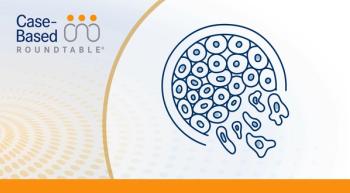
Mechanisms of Resistance and Progression in Multiple Myeloma
Paul G. Richardson, MD:There are a variety of mechanisms of resistance to multiple myeloma, and in this particular case, the gentleman did well from December 2013 to 2015 on lenalidomide and dexamethasone combined together with bisphosphonate use for his bone disease. By December of 2015, however, his IgM monoclonal gammopathy had returned increased, and at the same time, there was a decision made to increase his lenalidomide to 25 mg daily.
Now, I think that was perfectly reasonable as the therapeutic choice, on the basis that there may be a dose response relationship with lenalidomide. In our own practice, we tend to think of classes of drugs. And so what we would say is that they’ve been on an immunomodulatory, the patient is doing reasonably well, but has a biochemical progression, rather like the case before. We might ask, “Well, what can we add that might be better in terms of outcome?”
Now, steroids in someone like this, an older gentleman, has its caveatssteroid side effects are very real. So, the question would be, could you add, for example, a proteasome inhibitor to this platform? Or actually, with that biochemical progression that we just described, could we switch to a more potent IMiD? And so, a very reasonable choice—rather than increasing the dose of lenalidomide, perhaps—would have been perhaps to have moved to a drug like pomalidomide in this gentleman. Because we know that when lenalidomide fails a patient, pomalidomide can salvage in the relapse setting at a rate of approximately at least a third. And then, when you add an additional agent to that, the response rates are even better. So, a reasonable strategy for this gentleman might have been [to] move from lenalidomide to pomalidomide and add an additional agent, if needed, at the time of this initial progression back in December of 2015.
So, that’s one particular approach to resistance. For example, can you adjust your IMiD class or add an additional class of drug to circumvent the resistance pathways that have been merged? An emerging other approach to managing resistance in myeloma is the use of completely non-overlapping mechanisms of action, such as monoclonal antibodies, and even now, the histone deacetylase inhibitor pathways and other small molecule strategies.
All of those are attractive, but I think it’s important to remember that the sort of backbone approach to therapy in myeloma remains immunomodulation and proteasome inhibition. And appropriately adding to that platform probably has the strongest rationale. So, in sum, myeloma mechanisms of resistance are complex. They’re both within the myeloma and in the microenvironment. But in a therapeutic sense, how we challenge them is to think about how we can appropriately adjust what we’re already using and add to it in a rational combinatorial fashion to overcome the resistance that may be emerging.
In the context of thinking about our gentleman who progressed in December of 2015, who had his lenalidomide dose increased at the time of biochemical progression and appears to be functioning well otherwise, this is one definition of progression. This is biochemical progression where there is not necessarily a concomitant end organ injury associated with the rise in M protein. And that’s a very important distinction, because obviously that’s a patient in whom you have more time to make your choices, adjust your treatment, and so forth.
The other form of progression is not only a rise in M protein, but some end organ damage. And in our particular case, this gentleman, in May 2016, does exactly that, despite increasing his lenalidomide to 25 mg approximately 5 months before. He complains now of increasing bone pain, fatigue, and weakness. In fact, he’s hospitalized for pneumonia. That’s a classical, clinical progressionreflects both bone disease and his bone pain, [as well as] fatigue because the disease burden is increasing. And then, he has pneumonia. Pneumonia is a real signal that his myeloma is active.
Why? Because pneumonia, of course, is a function of immunoparesis in this patient, and his immune system is literally compromised by his progressive myeloma, and we recognize that infection is really, in my clinical experience, a very important signal that a person’s disease may be becoming more difficult to control. And on that note, his laboratory findings absolutely confirm that. So, we see both biochemical and end organ damage. Most importantly, in terms of the biochemical injury, we see a reduction in creatinine clearance. We see suppression of his albumin, and at the same time, now he has radiological evidence of progression. Furthermore, the team looking after him [does] the right thing by rechecking his bone marrow, and they show that he does have a significant plasmacytosis. And in that context, additional treatment is clearly indicated. And then you would move on to your next salvage regimen.
Case Scenario 2:
December 2013
- The patient is a 77-year old African American male who was diagnosed 24 months ago with stage III multiple myeloma and not eligible for transplant based on his level of frailty. His cytogenetics were classified as intermediate risk.
- He received treatment with lenalidomide (15 mg daily) and low-dose dexamethasone.
December 2015
- IgA monoclonal protein spike seen on SPEP. M-protein level has risen to 0.6 g/dl.
- He continued to do well functionally.
- Lenalidomide was increased to 25 mg daily.
May 2016
- The patient now complains of increasing back pain, fatigue and weakness. He was hospitalized two months ago for pneumonia.
- Abnormal laboratory findings show:
- Serum beta-2-microglobulin level, 6.2 mg/L
- Albumin level of 2.1 g/dL.
- Creatinine clearance of 32 ml/min
- Skeletal survey shows lytic lesions in the L4/L5 vertebrae.
- Bone marrow biopsy shows 30% involvement by abnormal appearing plasma cells, confirmed by CD138+ IHC stain.
- ECOG performance status is 2.
- The patient was started on pomalidomide, weekly cyclophosphamide, and low-dose dexamethasone.







































